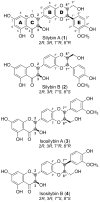HiFSA fingerprinting applied to isomers with near-identical NMR spectra: the silybin/isosilybin case
- PMID: 23461697
- PMCID: PMC3640553
- DOI: 10.1021/jo302720h
HiFSA fingerprinting applied to isomers with near-identical NMR spectra: the silybin/isosilybin case
Abstract
This study demonstrates how regio- and diastereo-isomers with near-identical NMR spectra can be distinguished and unambiguously assigned using quantum mechanical driven (1)H iterative Full Spin Analysis (HiFSA). The method is illustrated with four natural products, the flavonolignans silybin A, silybin B, isosilybin A, and isosilybin B, which exhibit extremely similar coupling patterns and chemical shift differences well below the commonly reported level of accuracy of 0.01 ppm. The HiFSA approach generated highly reproducible (1)H NMR fingerprints that enable distinction of all four isomers at (1)H frequencies from 300 to 900 MHz. Furthermore, it is demonstrated that the underlying numeric (1)H NMR profiles, combined with iterative computational analysis, allow parallel quantification of all four isomers, even in difficult to characterize reference materials and mixtures. The results shed new light on the historical challenges to the qualitative and quantitative analysis of these therapeutically relevant flavonolignans and open new opportunities to explore hidden diversity in the chemical space of organic molecules.
Conflict of interest statement
The authors declare no competing financial interest.
Figures










References
-
- Günther H. NMR spectroscopy: basic principles, concepts, and applications in chemistry. 2. Chapter 6. Wiley; Chichester; New York: 1995. pp. 199–219.
-
- Wiley RH, Crawford TH, Staples CE. J Org Chem. 1962;27:1535–1539.
-
- Abraham RJ, Warne MA, Griffiths L. Magn Reson Chem. 1998;36:S179–S188.
-
- Abraham RJ, Canton M, Griffiths L. Magn Reson Chem. 2001;39:421–431.
-
- Abraham RJ, Reid M. Magn Reson Chem. 2000;38:570–579.
Publication types
MeSH terms
Substances
Grants and funding
LinkOut - more resources
Full Text Sources
Other Literature Sources

